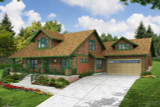Today’s homeowners are smartly maximizing the additional space of their bonus rooms to accommodate a range of contemporary activities, making it a highly functional room which looks great and offers something for the whole family.
The idea of a bonus room is actually a newer phenomenon and unique to the American culture. Prior to the 80’s, it was common for families to convert a garage in a single-level ranch home into a “rec room”. Parents imagined a spot where the family could play board games and listen to records on the console stereo system.
Since then, the average home size has grown from about 1650 square feet in the 70’s to over 2600 square feet today. The original recreation room idea has now evolved into a common requirement for a family-sized home.
Rick McAlexander of Associated Designs in Eugene, Oregon has designed thousands of homes over the last 30 years. He’s seen the bonus room become one of the most highly requested features of a new home. According to Rick, by using a loft truss in the construction of the home, he can create efficient space in the attic over the garage that can become an extra room at an affordable cost. An attic truss has a steeper roof, which adds additional head room.
The truss system is a great multitasker. It provides a lightweight, very strong roof while offering additional volume for bonus living space. This additional space can be left unfinished to be completed as a family’s budget and lifestyle create the opportunity to spread out, or it can be completed at the same time as the rest of the house. Good insulation and energy efficient windows create a comfortable place for friends and family to enjoy.
“Taking advantage of the extra space trusses can provide will result in the traditional bonus room with a sloped ceiling,” says Rick. “This is a great opportunity to incorporate built-ins, storage closets and other functional spaces that take advantage of the slopes,” he states.
A classic Craftsman style home, like Associated Designs’ Carrington 30-360 plan, is a perfect example of how to add bonus space to a smaller footprint. The main house lives large at 2049 square feet, while the extra bonus space is a few steps up and over the garage, adding another 350 feet to the overall plan. And, this plan calls for a window on every wall, ensuring loads of natural light that prevent the space from feeling like an attic.
Today’s savvy decorators know how to incorporate many elements that create a contemporary living space with fresh styling. Built-in cabinetry under the eaves includes a counter top, drawers and cubes for a crafting environment where projects can sit until completed. A finished crawl-space storage closet keeps seasonal clothing or extra linens fresh and ready for quick use. Library shelving under the eaves provides a wealth of space for books and keepsakes.
A kitchenette can include a wet sink and counter with microwave, with wine cooler and compact refrigerator. Add a built-in day bed and the bonus room becomes a gracious spot for overnight guests.
Maximizing every part of the bonus room with tricks of the building trade ensures the room is well used and enjoyed by all.
As Seen on Newswire


